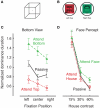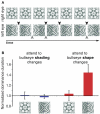Understanding attentional modulation of binocular rivalry: a framework based on biased competition
- PMID: 22144958
- PMCID: PMC3228993
- DOI: 10.3389/fnhum.2011.00155
Understanding attentional modulation of binocular rivalry: a framework based on biased competition
Abstract
Starting from early scientific explorations of binocular rivalry, researchers have wondered about the degree to which an observer can exert voluntary attentional control over rivalry dynamics. The answer to this question would not only reveal the extent to which we may determine our own conscious visual experience, but also advance our understanding of the neural mechanisms underlying binocular rivalry. Classic studies, intriguingly, reached contradictory conclusions, ranging from an absence of attentional control, as advocated by Breese, to nearly complete control of rivalry dynamics, as reported by Helmholtz. Recent investigations have revisited this question, but the results have continued to echo the conflicting findings of earlier studies, seemingly precluding a comprehensive understanding of attentional effects on rivalry. Here, we review both classic and modern studies, and propose a unifying framework derived from the biased competition theory of attention. The key assumption of this theory is that the nature of stimulus conflict determines the limits of attentional modulation. For example, a condition in which unresolved stimulus conflict transpires through many levels of visual processing should be very susceptible to attentional control. When applied to binocular rivalry, this framework predicts strong attentional modulations under conditions of unresolved stimulus conflict (e.g., initial selection) and conditions where conflict is resolved at higher levels of visual processing (e.g., stimulus rivalry). Additionally, the efficacy of attentional control over rivalry can be increased by utilization of demanding, behaviorally relevant tasks, and likely through perceptual training paradigms. We show that this framework can help facilitate the understanding and synthesis of a diverse set of results on attentional control over rivalry, and we propose several directions for future research on this interesting topic.
Keywords: biased competition; binocular rivalry; bistable perception; visual attention.
Figures





Similar articles
-
Attentional modulation of binocular rivalry.Front Hum Neurosci. 2011 Sep 27;5:105. doi: 10.3389/fnhum.2011.00105. eCollection 2011. Front Hum Neurosci. 2011. PMID: 22046156 Free PMC article.
-
Perceptual training profoundly alters binocular rivalry through both sensory and attentional enhancements.Proc Natl Acad Sci U S A. 2016 Nov 8;113(45):12874-12879. doi: 10.1073/pnas.1602722113. Epub 2016 Oct 24. Proc Natl Acad Sci U S A. 2016. PMID: 27791061 Free PMC article.
-
Can attention selectively bias bistable perception? Differences between binocular rivalry and ambiguous figures.J Vis. 2004 Jul 1;4(7):539-51. doi: 10.1167/4.7.2. J Vis. 2004. PMID: 15330700 Free PMC article.
-
Single units and conscious vision.Philos Trans R Soc Lond B Biol Sci. 1998 Nov 29;353(1377):1801-18. doi: 10.1098/rstb.1998.0333. Philos Trans R Soc Lond B Biol Sci. 1998. PMID: 9854253 Free PMC article. Review.
-
The 'laws' of binocular rivalry: 50 years of Levelt's propositions.Vision Res. 2015 Apr;109(Pt A):20-37. doi: 10.1016/j.visres.2015.02.019. Epub 2015 Mar 4. Vision Res. 2015. PMID: 25749677 Review.
Cited by
-
Individual differences in sensory eye dominance reflected in the dynamics of binocular rivalry.Vision Res. 2017 Dec;141:40-50. doi: 10.1016/j.visres.2016.09.014. Epub 2016 Oct 26. Vision Res. 2017. PMID: 27756700 Free PMC article.
-
Negligible fronto-parietal BOLD activity accompanying unreportable switches in bistable perception.Nat Neurosci. 2015 Nov;18(11):1672-8. doi: 10.1038/nn.4130. Epub 2015 Oct 5. Nat Neurosci. 2015. PMID: 26436901 Free PMC article.
-
Visual working memory content influences correspondence processes.J Exp Psychol Hum Percept Perform. 2021 Mar;47(3):331-343. doi: 10.1037/xhp0000890. Epub 2021 Jan 28. J Exp Psychol Hum Percept Perform. 2021. PMID: 33507771 Free PMC article.
-
fMRI neurofeedback of higher visual areas and perceptual biases.Neuropsychologia. 2016 May;85:208-15. doi: 10.1016/j.neuropsychologia.2016.03.031. Epub 2016 Mar 26. Neuropsychologia. 2016. PMID: 27020139 Free PMC article.
-
Persistent Biases in Binocular Rivalry Dynamics within the Visual Field.Vision (Basel). 2017;1(3):18. doi: 10.3390/vision1030018. Epub 2017 Jun 29. Vision (Basel). 2017. PMID: 31535055 Free PMC article.
References
-
- Alais D., Blake R. (ed.). (2005). Binocular Rivalry. Cambridge: MIT Press
Grants and funding
LinkOut - more resources
Full Text Sources

